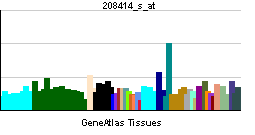HOXB3
| Homeobox B3 | |||||||||||
|---|---|---|---|---|---|---|---|---|---|---|---|
| Identifiers | |||||||||||
| Symbols | HOXB3 ; HOX2; HOX2G; Hox-2.7 | ||||||||||
| External IDs | Template:OMIM5 Template:MGI HomoloGene: 1617 | ||||||||||
| |||||||||||
| RNA expression pattern | |||||||||||
 | |||||||||||
| More reference expression data | |||||||||||
| Orthologs | |||||||||||
| Template:GNF Ortholog box | |||||||||||
| Species | Human | Mouse | |||||||||
| Entrez | n/a | n/a | |||||||||
| Ensembl | n/a | n/a | |||||||||
| UniProt | n/a | n/a | |||||||||
| RefSeq (mRNA) | n/a | n/a | |||||||||
| RefSeq (protein) | n/a | n/a | |||||||||
| Location (UCSC) | n/a | n/a | |||||||||
| PubMed search | n/a | n/a | |||||||||
Homeobox B3, also known as HOXB3, is a human gene.[1]
This gene is a member of the Antp homeobox family and encodes a nuclear protein with a homeobox DNA-binding domain. It is included in a cluster of homeobox B genes located on chromosome 17. The encoded protein functions as a sequence-specific transcription factor that is involved in development. Increased expression of this gene is associated with a distinct biologic subset of acute myeloid leukemia (AML).[1]
See also
References
Further reading
- Scott MP (1992). "Vertebrate homeobox gene nomenclature". Cell. 71 (4): 551–3. PMID 1358459.
- McAlpine PJ, Shows TB (1990). "Nomenclature for human homeobox genes". Genomics. 7 (3): 460. PMID 1973146.
- Giampaolo A, Acampora D, Zappavigna V; et al. (1989). "Differential expression of human HOX-2 genes along the anterior-posterior axis in embryonic central nervous system". Differentiation. 40 (3): 191–7. PMID 2570724.
- Acampora D, D'Esposito M, Faiella A; et al. (1990). "The human HOX gene family". Nucleic Acids Res. 17 (24): 10385–402. PMID 2574852.
- Boncinelli E, Acampora D, Pannese M; et al. (1990). "Organization of human class I homeobox genes". Genome. 31 (2): 745–56. PMID 2576652.
- Guazzi S, Lonigro R, Pintonello L; et al. (1994). "The thyroid transcription factor-1 gene is a candidate target for regulation by Hox proteins". EMBO J. 13 (14): 3339–47. PMID 7913891.
- Apiou F, Flagiello D, Cillo C; et al. (1996). "Fine mapping of human HOX gene clusters". Cytogenet. Cell Genet. 73 (1–2): 114–5. PMID 8646877.
- Bingle CD, Gowan S (1996). "Oct-1 interacts with conserved motifs in the human thyroid transcription factor 1 gene minimal promoter". Biochem. J. 319 ( Pt 3): 669–74. PMID 8920965.
- Sauvageau G, Thorsteinsdottir U, Hough MR; et al. (1997). "Overexpression of HOXB3 in hematopoietic cells causes defective lymphoid development and progressive myeloproliferation". Immunity. 6 (1): 13–22. PMID 9052833.
- Guazzi S, Pintonello ML, Viganò A, Boncinelli E (1998). "Regulatory interactions between the human HOXB1, HOXB2, and HOXB3 proteins and the upstream sequence of the Otx2 gene in embryonal carcinoma cells". J. Biol. Chem. 273 (18): 11092–9. PMID 9556594.
- Viganò MA, Di Rocco G, Zappavigna V, Mavilio F (1998). "Definition of the transcriptional activation domains of three human HOX proteins depends on the DNA-binding context". Mol. Cell. Biol. 18 (11): 6201–12. PMID 9774637.
- Kosaki K, Kosaki R, Suzuki T; et al. (2002). "Complete mutation analysis panel of the 39 human HOX genes". Teratology. 65 (2): 50–62. doi:10.1002/tera.10009. PMID 11857506.
- Nakamura N, Yoshimi T, Miura T (2002). "Increased gene expression of lung marker proteins in the homeobox B3-overexpressed fetal lung cell line M3E3/C3". Cell Growth Differ. 13 (4): 195–203. PMID 11971819.
- Ota T, Suzuki Y, Nishikawa T; et al. (2004). "Complete sequencing and characterization of 21,243 full-length human cDNAs". Nat. Genet. 36 (1): 40–5. doi:10.1038/ng1285. PMID 14702039.
- Pineault N, Abramovich C, Ohta H, Humphries RK (2004). "Differential and common leukemogenic potentials of multiple NUP98-Hox fusion proteins alone or with Meis1". Mol. Cell. Biol. 24 (5): 1907–17. PMID 14966272.
- Roche J, Zeng C, Barón A; et al. (2004). "Hox expression in AML identifies a distinct subset of patients with intermediate cytogenetics". Leukemia. 18 (6): 1059–63. doi:10.1038/sj.leu.2403366. PMID 15085154.
- Brandenberger R, Wei H, Zhang S; et al. (2005). "Transcriptome characterization elucidates signaling networks that control human ES cell growth and differentiation". Nat. Biotechnol. 22 (6): 707–16. doi:10.1038/nbt971. PMID 15146197.
- Speleman F, Cauwelier B, Dastugue N; et al. (2005). "A new recurrent inversion, inv(7)(p15q34), leads to transcriptional activation of HOXA10 and HOXA11 in a subset of T-cell acute lymphoblastic leukemias". Leukemia. 19 (3): 358–66. doi:10.1038/sj.leu.2403657. PMID 15674412.
- Kimura K, Wakamatsu A, Suzuki Y; et al. (2006). "Diversification of transcriptional modulation: large-scale identification and characterization of putative alternative promoters of human genes". Genome Res. 16 (1): 55–65. doi:10.1101/gr.4039406. PMID 16344560.
External links
- HOXB3+protein,+human at the US National Library of Medicine Medical Subject Headings (MeSH)
This article incorporates text from the United States National Library of Medicine, which is in the public domain.
| This protein-related article is a stub. You can help Wikipedia by expanding it. |